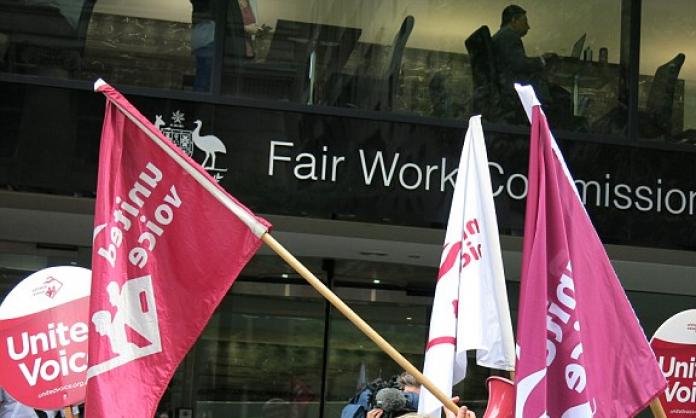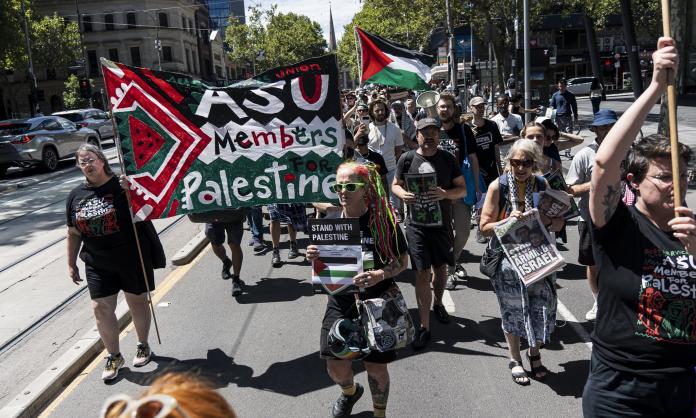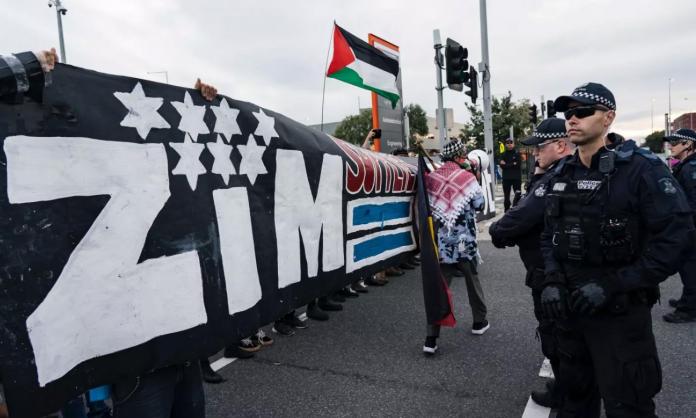The cuts to penalty rates by the Fair Work Commission are not the first anti-working class decisions taken by this body and they won’t be the last. The Fair Work Commission and its predecessor organisations have for more than a century attacked workers’ wages, undermined conditions of employment and restricted workers’ right to strike. Far from being the “independent umpire”, the commission is well and truly in the pockets of the bosses and governments. Everything that workers have won in past generations has been won not courtesy of the commission but by the struggle of workers on the job.
The origins of arbitration
The Fair Work Commission has its origins in the devastating defeat suffered by the trade unions in the first half of the 1890s when employers, courts, governments and police colluded to smash organised labour through a combination of lockouts and repression. The outcome was catastrophic: unions and union membership collapsed. As far as most of the bosses were concerned, that was it – the union threat had been crushed.
But wiser heads in the state – liberal politicians such as prime minister Alfred Deakin, SA premier Charles Kingston and the Victorian, future attorney-general and High Court justice, Henry Bournes Higgins – realised that the unions could not be squashed forever. So they promoted arbitration as a way of dampening the class struggle.
In 1901, an arbitration court was established in NSW and three years later, in the face of bitter opposition from conservatives and most employers, the Reid government passed the federal Arbitration Act. Its chief object was “to prevent lockouts and strikes in relation to industrial disputes”. Strikes were prohibited under pain of a penalty of 1,000 pounds for either a person or an organisation.
The liberal architects of arbitration were backed by the ALP and by many trade union leaders who believed that arbitration would be a way to defend workers’ conditions without having to risk union assets in strikes. Arbitration was opposed by some in the working class movement – such as the socialist William Lane – on the basis that it would tie the unions to the state. But opponents were in a minority. Demoralisation following the big defeats in the previous decade meant that many were willing to give arbitration a go, although there was more resistance in NSW than Victoria.
An early enticement for the unions was the introduction of a “living wage”, which came about with the Harvester Judgement of 1907 when the new Arbitration Court laid down a minimum standard of seven shillings a day for male labourers and 10 shillings for skilled tradesmen. For the former, this was a 27 percent wage increase. The Basic Wage, as it came to be called, was then enshrined in awards that established a floor of conditions for industries and occupations across the country. As early as 1914, 80 percent of the workforce was covered by an award.
Limitations of arbitration
But the arbitration system was full of snares for the working class. For a start, the Basic Wage did not apply to workers operating under state jurisdiction. Applications for the making of awards under the new system involved a lengthy delay. The High Court did its best to stymie any changes favourable to workers. Women workers received significantly less than the Harvester rate. And the Basic Wage was not increased until 1913 – no sooner was it introduced than it was eaten away by inflation. During the Great Depression, the court ordered severe cuts to wages and conditions of employment for wharfies, timber workers and railway workers. In 1931, it cut the Basic Wage by 10 percent. Only in 1937 was the Basic Wage restored. The result was that its value did not increase at all between 1907 and 1946.
Between 1948-49 and 1970-71, a period of economic expansion and full employment, when in other circumstances workers would have been able to push up their share of national income, arbitration was responsible for a fall in labour’s share. In 1964, when workers at GMH struck for four weeks for a share of the company’s bumper profits, their claim was denied by the Arbitration Commission (as the Court was renamed in 1956) on the grounds that the company’s capacity to pay was irrelevant in granting workers wage rises.
Workers received a sharp jump in their share of the pie only when they went on strike in large numbers, as they did after World War Two and again in the late 1960s and early 1970s.
Furthermore, while the Basic Wage was periodically increased in line with inflation, no such adjustment was made to the skilled component, the so-called “margins”. These were only increased on an ad hoc basis. The result was that skilled workers had to pressure the employers directly to win any increase above the Basic Wage increase.
Arbitration did nothing to limit the power of the boss at the workplace. The court ruled that all the big decisions about staffing, introduction of new machinery, hiring and firing, in short, “the manner in which an employer conducts his business”, were the preserve of “managerial prerogative”. As long as the bosses observed the award and the meagre workplace health and safety laws, they were free to mistreat workers, to exploit them mercilessly and to victimise union delegates. This was particularly the case in small and medium sized businesses, in which the boss was given a free hand in the absence of trade unions and the paucity of enforcement by departments of labour. Union intervention was the only way to make sure that workers were getting their award conditions.
The court was ineffective or had nothing to say about employers calling on state and federal governments to smash strikes, even when, as in the four-month lockout at Broken Hill in 1909, the workers’ action was designed to force the employer simply to pay award wages determined by the court itself. Increasingly, workers who had been willing to give arbitration a chance now turned against it.
Arbitration and the unions
Perhaps more significant than any of these issues was the impact arbitration had on trade unions. The system of arbitration was built around trade unions as representative bodies of workers. The court therefore encouraged union membership. But it also encouraged the most industrially passive and bureaucratic forms of trade unionism.
This is most obvious with workers exercising their right to strike. Successive courts restricted workers’ ability to strike, through such means as secret ballots, limits on picketing and compulsory conferences at which the union was instructed to call off any strike in progress. And when these were not sufficient, they were backed up with significant fines. Between 1956 and 1969, the industrial court levied 800 fines against striking unions at the behest of the Arbitration Commission. These totalled $282,000 (not adjusted for inflation); adding legal costs the total came to $590,000. Only after a general strike in Victoria and Queensland in 1969 were these penal powers struck down.
As well as levying big fines, the court could also deregister militant unions, removing them from the award system. It did this repeatedly in the 1940s and 1950s with the BWIU, AEU, FEDFA and again with the BLF in the 1970s and 1980s. While this did not wipe these unions out, deregistration was a useful threat to rein in militancy.
Little wonder that the conservatives and employers, initially enemies of arbitration, became its strongest supporters in the post-war decades: every time unions appeared to be mustering their forces for a strike, the bosses hastened to the court in an attempt to cut the process short. They weren’t always successful because many times workers struck regardless, but the system certainly helped because it encouraged all the worst and most bureaucratic elements of the labour movement.
Arbitration gave a natural platform for the right wing union leaders who could point to arbitration rather than strikes as the way for workers to win their rights. It gave them a natural scapegoat when the court refused to deliver the increases sought by the workers: the officials could just blame the court to deflect from their own lethargy. The right wing leaders loved the penal powers because they provided an additional excuse for inactivity. And, because the court granted rights of entry to worksites only to those it judged “fit and proper persons”, it provided the right wing in the unions with a stick to beat the militants.
Arbitration also concentrated union resources in legal cases, wasting tens of thousands of pounds of members’ money and thousands of hours of staff time. And, at the height of the Cold War in 1949-50, the court intervened to overturn decisions taken by Communist-run unions as to how they conducted their internal affairs.
Arbitration attempted to reduce union delegates to the role of observers in their own disputes. Rather than galvanising members on strikes and picket lines, and reaching out to other groups of workers for solidarity, job representatives were told simply to wait for the findings of the court, which invariably took weeks, if not months. This was the preferred tactic of the right wing union officials who loathed strikes and militant union delegates.
But the left wing union leaders used arbitration in this way as well. One notable case was during a strike by power workers, members of the Communist-led AMWU, in the Latrobe Valley in Victoria in 1977. These workers had immense power to shut down industry across the state, but they were instead made to attend interminable hearings at the Arbitration Commission in Melbourne, which ensured that the initial energy of the strike dissipated.
By granting unions exclusive coverage rights over particular groups of workers or industries on a first-come, first-served basis, arbitration for decades propped up hundreds of right wing, do-nothing unions who could run to the court to fend off any encroachment on “their” territory by more aggressive unions. In this, they were supported enthusiastically by the employers. Most of these unions were small and were the natural political base for the bigger right wing unions on the various state and national labour councils. In the 1950s and 1960s, these were a constant drag on the more militant unions in the Victorian Trades Hall Council – until the latter broke away in 1967 to chart a more militant course.
Arbitration is often credited with winning workers big gains in wages and conditions. But in every case, the big gains have been spearheaded by the more militant unions going on strike to establish industrial facts on the ground. Take wages, for example. Only strikes by the stronger unions secured higher wages from the bosses and put pressure on the commission to generalise the increases to other groups of workers. The same was true with equal pay for women. The commission’s 1969 decision was preceded by several decades of union struggle to eliminate the pay gap.
Shorter working hours legislation by the NSW state government, which cut the working week from 48 hours to 44 hours and then to 40 hours, was the result of big waves of strikes in the late 1940s and again in the early 1960s – or by the simple expedient of workers knocking off work having done the target number of hours. The same was true with progressive extensions of paid recreation leave from one week to four. The pattern was that the stronger groups of workers would win the claim through their own action and then use the established industrial fact to generalise the improvement through arbitration or government legislation. Militants worked on the principle: “What you can’t win on the grass [i.e. by going on strike], you won’t win in the courts”.
Arbitration today
Between the 1940s and the 1980s, bosses and governments valued arbitration as a means of pacifying the labour movement. Although it certainly didn’t prevent strikes – Australia had one of the highest strike rates in the world – it did serve as an important backstop to limit militancy and helped to prop up the more conservative forces in the unions.
Starting in the 1980s, the ruling class began to change its mind. Unions had failed to successfully resist two waves of mass sackings in the economic downturns of the mid-1970s and early-1980s and then, under the Accord arrangement between the Hawke Labor government and ACTU, had demonstrated their willingness to forego the strike weapon in return for modest legislative measures by the government.
In the mid-1980s real wages began to fall for the first time since the Great Depression, not in the teeth of union opposition but with its support. Former union activists who had once led militant strikes now became advocates of “industry restructuring”, sitting down with bosses to find out ways of cutting jobs and conditions. Those unions that showed any fight, like the Builders Labourers Federation, were smashed with the support of the ACTU. The strike rate collapsed and is now at record low levels.
With unions failing to fight, they increasingly found it difficult to recruit and hold new members. Membership coverage fell at an accelerating pace. From one-half of the workforce, coverage fell to one-third, then to one-quarter. Today it is less than one in six.
As the unions became weaker and weaker, the bosses saw less need for arbitration. More and more, they began to entertain the idea of driving the unions out of their businesses and, where this was impractical, to further weaken them by breaking up the old system of industry-wide bargaining and awards in favour of enterprise bargaining, negotiations undertaken business by business, unit by unit. No longer would gains in the strongly organised workplaces flow through to workers in weak workplaces. No longer would the bosses face industry-wide strikes. Solidarity was eroded. And, with strikes forbidden during the life of enterprise agreements, the bosses could always prepare well in advance of a union wage claim to diminish the effectiveness of any industrial action that did take place.
Awards have been relegated to a much less significant role in the industrial set-up. Successive rounds of award restructuring, simplification, modernisation and rationalisation have gutted them, with important restrictions on things like the use of part time work, regulation of rosters, union rights to negotiate changes to staffing etc. simply stripped out.
It is this process that is responsible for the Fair Work Commission’s decision to cut penalty rates today. It is also something that was initiated by the Labor Party and has been backed by trade union leaders, all part of the attempt to make Australian industry “competitive” and “efficient”. A few dollars have been thrown workers’ way in some cases as compensation, but the outcome has been the sacrifice of conditions that were decades in the making by generations of union activists.
Award rates of pay have fallen further behind the “going rate” in enterprise agreements. But where unions are broken, this is where many workers end up. Minimum wages are adjusted twice yearly but they are far below the EBA rate.
Arbitration has become a less important weapon in the armoury of the bosses. But it’s not irrelevant. It still plays an important disciplinary function. All the anti-strike provisions of the old arbitration acts are still in place; any strike or action that begins to bite quickly results in the union being dragged into arbitration – where it is usually instructed to cancel the action. But when unions are being bashed by the employers in the field, the Fair Work Commission looks the other way: nothing to do with us, sort it out yourselves, they urge the unions.
The problem we face is that the union leaders are not willing to fight fire with fire. The bosses and governments have ramped up their aggression against unions with organisations such as the ABCC. They haven’t won the political war – by and large, the public oppose attacks on the award system and minimum wages. But they’re winning the industrial war, evidenced by stagnant wages, the collapse in union membership and the virtual disappearance of strikes. The union leaders hope that the return of a Labor government will halt the offensive. It may slow things down for a while but the Rudd-Gillard governments did little to reverse the tide.
The whole history of the arbitration system tells us one simple lesson: that we can’t rely on governments or tribunals to improve things for workers. The penalty rates decision shows us the opposite. We have to rebuild unions on the basis on which they punched through in earlier times: through an aggressive campaign of mass industrial and political action that utilises the main weapon at workers’ disposal, the weapon that arbitration was designed to muzzle, the strike.
Tom Bramble is author of Trade Unionism in Australia: A History from Flood to Ebb Tide, Cambridge University Press, 2008











